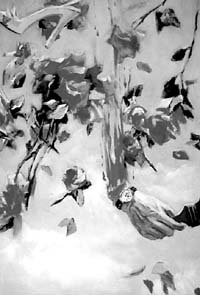Conceptualism Is Dead

The Love Your Symptom exhibition at the Center for the Contemporary Art is dedicated to painting, which is, according to the project’s concept, a phenomenon reborn and an alternative to the invasion of virtual technologies.
Still, one should be careful with such bombast terminology. Painting, be it of high quality and work of a great talent, traditional or experimental, has never died. One should rather speak on its rising from nonexistence in the territory of actual projective art where the aforementioned technologies rule. Moscow-based painters Aleksandr Vinogradov and Vladimir Dubossarsky are most renowned in this field today. Their works, playing up cultural, historical, and social myths, became a kind of an export forefront for contemporary Russian art and, to all appearances, enjoy considerable success at various biennials. However, in Kyiv the renowned duet was represented not with its monumental paintings but rather small works like Zorro in Moscow (showing the best correlation with its title) or The Last Sunbeam (Mickey Mouse admiring a typical middle-Russia sunset). The painting, which became a symbol of the exhibition, Artist and His Model, depicts red roses dispersed by an explosion, a torn away hand holding a brush, ladies’ shoes, and traces of blood. All this reminds a still from a popular thriller by, say, John Vought. Thus the painters still did not go far from the digital arts. The Catastrophes series by St. Petersburg based Dmitry Shorin is, in fact, copied from photos. Kyivan Illia Chychkan’s endless bunnies also look very mechanistic. Poor little things in the pictures are doing God-knows-what, but look like clones reproduced by pressing a button key. Odesa-based Ihor Husev depicts scared little girls in the open in correspondence with all classic composition rules, but he could as well find live models and take their photographs, drawing landscapes on the computer.
Czech painter – Jiri Suruvka seems the most original. His sarcastic and inventive paintings are infused with Dadaism and Expressionism Central European traditions. However, using already existing techniques does not harm the author, since he knows what he is doing and what for; his goal is obvious, his position clear and well defined. Suruvka refuses to play language games but attacks, in best traditions of the classic Western avant-garde, the reality, which he actively dislikes. It is exactly his originality that makes him an outsider in the exposition. His symptom is obviously different; maybe it is not even there, as well as the disease itself.
Others’ disease is hereditary. All this had already happened before, starting with famous and fruitful Moscow conceptualism of the 1970s and 1980s, later transformed into soc-art. Paintings had already appeared compiled from textbook classic stereotypes and Soviet agitprop, a mixture of academy art and mass culture. They were universal, successful, and profitable, though never laid claims to be called painting, remaining on a level of multiplied gestures.
Thus, one can hardly speak of a disease as such. Evidently, an appeal to love one’s symptom is nothing but a pose. The exhibition at the Center for Contemporary Arts represents rather a statement of fact with no love at all.
From this it follows, conceptualism is dead.






